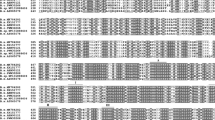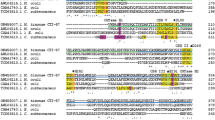Abstract
The gene encoding the branching enzyme (BE) from the thermoalkaliphilic, anaerobic bacterium Anaerobranca gottschalkii was fused with a twin arginine translocation protein secretory-pathway-dependent signal sequence from Escherichia coli and expressed in Staphylococcus carnosus. The secreted BE was purified using hydrophobic interaction and gel filtration chromatography. The monomeric enzyme (72 kDa) shows maximal activity at 50°C and pH 7.0. With amylose the BE displays high transglycosylation and extremely low hydrolytic activity. The conversion of amylose and linear dextrins was analysed by applying high-performance anion exchange chromatography and quantitative size-exclusion chromatography. Amylose (104–4×107 g/mol) was converted to a major extent to products displaying molecular masses of 104–4×105 g/mol, indicating that the enzyme could be applicable for the production of starch or dextrins with narrow molecular mass distributions. The majority of the transferred oligosaccharides, determined after enzymatic hydrolysis of the newly synthesized α-1,6 linkages, ranged between 103 and 104 g/mol, which corresponds to a degree of polymerisation (DP) of 6–60. The minimal donor chain length is DP 16. Furthermore, the obtained results support the hypotheses of a random endocleavage mechanism of BE and the occurrence of interchain branching.








Similar content being viewed by others
References
Antranikian G, Ruepp A, Freudl R, Liebl W, Sterner R, Klenk H-P (2004) A genomic perspective of the carbohydrate metabolism of thermoalkaliphilic bacterium Anaerobranca gottschalkii. In: International congress on biocatalysis 2004, Hamburg, 29 August–1 September 2004 p 28
Baecker PA, Greenberg E, Preiss J (1986) Biosynthesis of bacterial glycogen. Primary structure of Escherichia coli 1,4-α-d-glucan:1,4-α-d-glucan 6-a-d-(1, 4-α-d-glucano)-transferase as deduced from the nucleotide sequence of the glg B gene. J Biol Chem 261:8738–8743
Ballschmiter M, Armbrecht M, Ivanova K, Antranikian G, Liebl W (2005) AmyA, an α-amylase with β-cyclodextrin-forming activity, and AmyB from the thermoalkaliphilic organism Anaerobranca gottschalkii: two amylases adapted to their different cellular localizations. Appl Environ Microbiol 71:3709–3715
Bertoldo C, Armbrecht M, Becker F, Schafer T, Antranikian G, Liebl W (2004) Cloning, sequencing, and characterization of a heat- and alkali-stable type I pullulanase from Anaerobranca gottschalkii. Appl Environ Microbiol 70:3407–3416
Blaudeck N, Kreutzenbeck P, Freudl R, Sprenger GA (2003) Genetic analysis of pathway specificity during posttranslational protein translocation across the Escherichia coli plasma membrane. J Bacteriol 185:2811–2819
Blum H, Beier H, Gross HJ (1987) Improved silver staining of plant proteins, RNA and DNA in polyacrylamide gels. Electrophoresis 8:93–99
Borovsky D, Smith EE, Whelan WJ (1976) On the mechanism of amylose branching by potato Q-enzyme. Eur J Biochem 62:307–312
Bradford MM (1976) A rapid and sensitive method for the quantitation of microgram quantities of protein utilizing the principle of protein-dye binding. Anal Biochem 72:248–254
Britton HTS, Robinson RE (1931) Universal buffer solutions and the dissociation constants of veronal. J Chem Soc 1931:1456–1473
Buléon A, Colonna P, Planchot V, Ball S (1998) Starch granules: structure and biosynthesis. Int J Biol Macromol 23:85–112
Coutinho PM, Henrissat B (1999) http://afmb.cnrs-mrs.fr/~cazy/CAZY/index.html (carbohydrate-active enzyme server)
Deckert G, Warren PV, Gaasterland T, Young WG, Lenox AL, Graham DE, Overbeek R, Snead MA, Keller M, Aujay M, Huber R, Feldman RA, Short JM, Olsen GJ, Swanson RV (1998) The complete genome of the hyperthermophilic bacterium Aquifex aeolicus. Nature 392:353–358
Elias H-G (1990) Makromoleküle. Hüthig &Wepf, Basel
Endo T, Zheng M, Zimmermann W (2002) Enzymatic synthesis and analysis of large-ring cyclodextrins. Aust J Chem 55:39–48
Fujii K, Takata H, Yanase M, Terada Y, Ohdan K, Takaha T, Okada S, Kuriki T (2003) Bioengineering and application of novel glucose polymers. Biocatal Biotransform 21:167–172
Grubisic Z, Benoit H, Rempp P (1967) A universal calibration for gel permeation chromatography. Polym Lett 5:753–759
Guan H, Li P, Imparl-Radosevich J, Preiss J, Keeling P (1997) Comparing the properties of Escherichia coli branching enzyme and maize branching enzyme. Arch Biochem Biophys 342:92–98
Haney MA (1985) A differential viscometer. Am Lab (Fairfld) 17:116–126
Henrissat B (1991) A classification of glycosyl hydrolases based on amino acid sequence similarities. Biochem J 280(Pt 2):309–316
Janecek S, Svensson B, MacGregor EA (2003) Relation between domain evolution, specificity, and taxonomy of the α-amylase family members containing a C-terminal starch-binding domain. Eur J Biochem 270:635–645
Jobling SA, Schwall GP, Westcott RJ, Sidebottom CM, Debet M, Gidley MJ, Jeffcoat R, Safford R (1999) A minor form of starch branching enzyme in potato (Solanum tuberosum L.) tubers has a major effect on starch structure: cloning and characterisation of multiple forms of SBE A. Plant J 18:163–171
Kawabata Y, Toeda K, Takahashi T, Shibamoto N, Kobayashi M (2002) Preparation of highly branched starch by glycogen branching enzyme from Neurospora crassa N2-44 and its characterization. J Appl Glycosci 49:273–279
Kiel JA, Boels JM, Beldman G, Venema G (1991) Molecular cloning and nucleotide sequence of the glycogen branching enzyme gene (glgB) from Bacillus stearothermophilus and expression in Escherichia coli and Bacillus subtilis. Mol Gen Genet 230:136–144
Kiel JA, Boels JM, Beldman G, Venema G (1992) The glgB gene from the thermophile Bacillus caldolyticus encodes a thermolabile branching enzyme. DNA Seq 3:221–232
Kossmann J, Lloyd J (2000) Understanding and influencing starch biochemistry. Crit Rev Biochem Mol Biol 35:141–196
Krisman CR (1962) A method for the colorimetric estimation of glycogen with iodine. Anal Biochem 4:17–23
Laemmli UK (1970) Cleavage of structural proteins during the assembly of the head of bacteriophage T4. Nature 227:680–685
Larsen KL (2002) Large cyclodextrins. J Incl Phenom Macrocycl Chem 43:1–13
Machida S, Ogawa S, Xiaohua S, Takaha T, Fujii K, Hayashi K (2000) Cycloamylose as an efficient artificial chaperone for protein refolding. FEBS Lett 486:131–135
Melendez R, Melendez-Hevia E, Mas F, Mach J, Cascante M (1998) Physical constraints in the synthesis of glycogen that influence its structural homogeneity: a two-dimensional approach. Biophys J 75:106–114
Mikkelsen R, Binderup K, Preiss J (2001) Tyrosine residue 300 is important for activity and stability of branching enzyme from Escherichia coli. Arch Biochem Biophys 385:372–377
Nichols SE (2000) Glucan-containing compositions and papers. US Patent application 6465203
Okada S, Kitahata S, Yoshikawa S, Sugimoto T, Sugimoto K (1984) Process for the production of branching enzyme, and a method for improving the qualities of food products therewith. US Patent application 4454161
Poulsen P, Kreiberg JD (1993) Starch branching enzyme cDNA from Solanum tuberosum. Plant Physiol 102:1053–1054
Prowe SG, Antranikian G (2001) Anaerobranca gottschalkii sp. nov., a novel thermoalkaliphilic bacterium that grows anaerobically at high pH and temperature. Int J Syst Evol Microbiol 51:457–465
Radosta S, Haberer M, Vorwerg W (2001) Molecular characteristics of amylose and starch in dimethyl sulfoxide. Biomacromolecules 2:970–978
Shinohara ML, Ihara M, Abo M, Hashida M, Takagi S, Beck TC (2001) A novel thermostable branching enzyme from an extremely thermophilic bacterial species, Rhodothermus obamensis. Appl Microbiol Biotechnol 57:653–659
Sizemore C, Geissdorfer W, Hillen W (1993) Using fusions with luxAB from Vibrio harveyi MAV to quantify induction and catabolite repression of the xyl operon in Staphylococcus carnosus TM300. FEMS Microbiol Lett 107:303–306
Spendler T, Jørgensen O (1997) Use of a branching enzyme in baking. Patent application WO97/41736
Takata H, Takaha T, Okada S, Hizukuri S, Takagi M, Imanaka T (1996a) Structure of the cyclic glucan produced from amylopectin by Bacillus stearothermophilus branching enzyme. Carbohydr Res 295:91–101
Takata H, Takaha T, Okada S, Takagi M, Imanaka T (1996b) Cyclization reaction catalyzed by branching enzyme. J Bacteriol 178:1600–1606
Takata H, Takaha T, Nakamura H, Fujii K, Okada S, Takagi M, Imanaka T (1997) Production and some properties of a dextrin with a narrow size distribution by the cyclization reaction of branching enzyme. J Ferment Bioeng 84:119–123
Takata H, Ohdan K, Takaha T, Kuriki T, Okada S (2003) Properties of branching enzyme from the hyperthermophilic bacterium, Aquifex aeolicus, and its potential for production of highly-branched cyclic dextrins. J Appl Glycosci 50:15–20
Takeda Y, Guan HP, Preiss J (1993) Branching of amylose by the branching isozymes of maize endosperm. Carbohydr Res 240:253–263
Thiemann V, Donges C, Prowe SG, Sterner R, Antranikian G (2004) Characterisation of a thermoalkali-stable cyclodextrin glycosyltransferase from the anaerobic thermoalkaliphilic bacterium Anaerobranca gottschalkii. Arch Microbiol 182:226–235
Thon VJ, Vigneron-Lesens C, Marianne-Pepin T, Montreuil J, Decq A, Rachez C, Ball SG, Cannon JF (1992) Coordinate regulation of glycogen metabolism in the yeast Saccharomyces cerevisiae. Induction of glycogen branching enzyme. J Biol Chem 267:15224–15228
Thon VJ, Khalil M, Cannon JF (1993) Isolation of human glycogen branching enzyme cDNAs by screening complementation in yeast. J Biol Chem 268:7509–7513
van der Maarel MJEC, van der Veen B, Uitdehaag JC, Leemhuis H, Dijkhuizen L (2002) Properties and applications of starch-converting enzymes of the α-amylase family. J Biotechnol 94:137–155
van der Maarel MJEJ, Vos A, Sanders P, Dijkhuizen L (2003) Properties of the glucan branching enzyme of the hyperthermophilic bacterium Aquifex aeolicus. Biocatal Biotransform 21:199–207
Vikso-Nielsen A, Blennow A, Hamborg Nielsen T, Lindberg Moller B (1998) Phosphorylated α-(1->4)glucans as substrate for potato starch-branching enzyme I. Plant Physiol 117:869–875
Waffenschmidt S, Jaenicke L (1987) Assay of reducing sugars in the nanomole range with 2,2′-bicinchoninate. Anal Biochem 165:337–340
Yokoyama W, Renner-Nantz JJ, Shoemaker CF (1998) Starch molecular mass and size by size-exclusion chromatography in DMSO-LiBr coupled with multiple angle laser light scattering. Cereal Chem 75:520–535
Acknowledgements
The authors thank Martina Reisen and Sascha Lebioda for their valuable technical contribution and the Deutsche Bundesstiftung Umwelt (German Federal Environmental Foundation) for financial support.
Author information
Authors and Affiliations
Corresponding author
Rights and permissions
About this article
Cite this article
Thiemann, V., Saake, B., Vollstedt, A. et al. Heterologous expression and characterization of a novel branching enzyme from the thermoalkaliphilic anaerobic bacterium Anaerobranca gottschalkii . Appl Microbiol Biotechnol 72, 60–71 (2006). https://doi.org/10.1007/s00253-005-0248-7
Received:
Revised:
Accepted:
Published:
Issue Date:
DOI: https://doi.org/10.1007/s00253-005-0248-7




